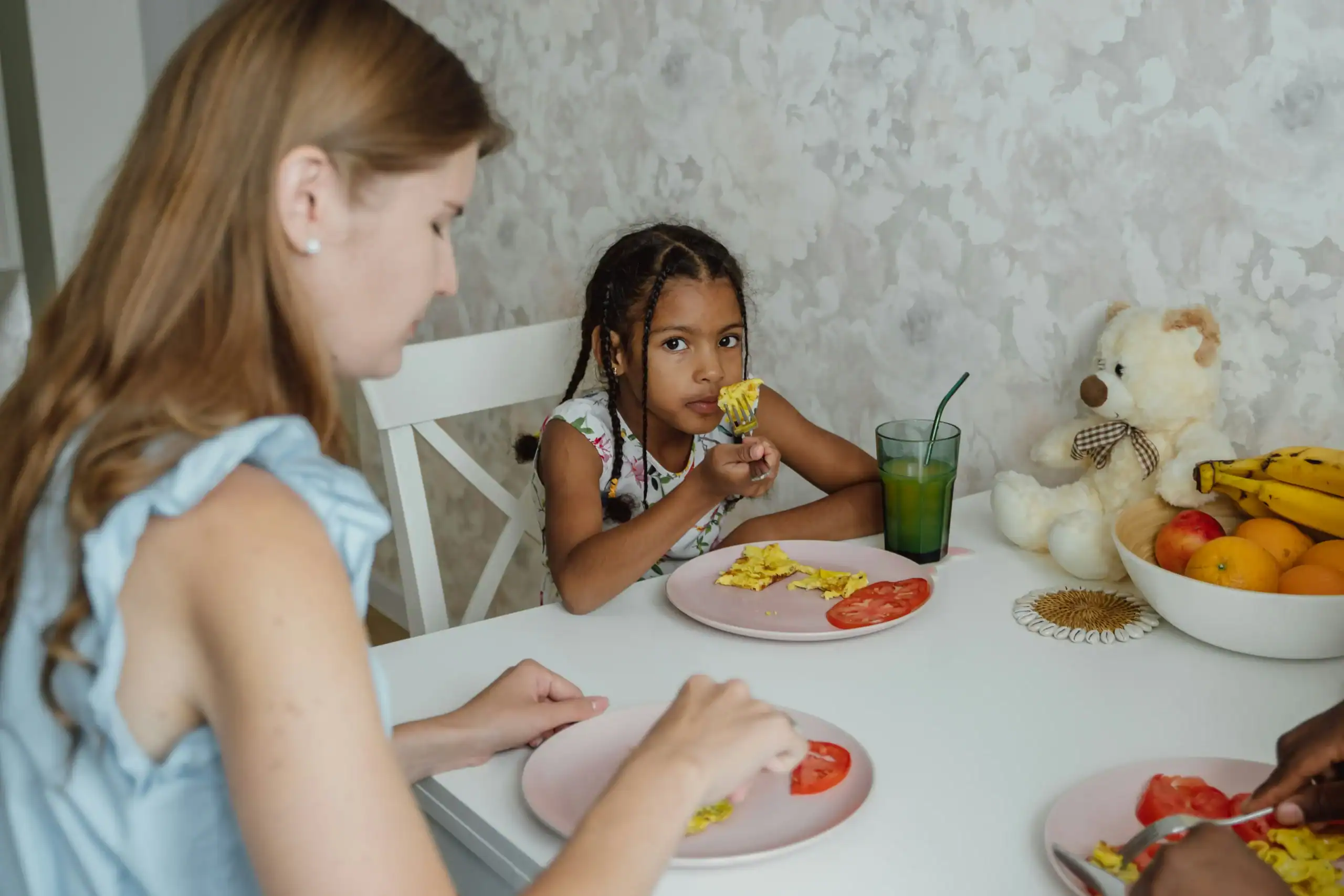If you’ve ever seen your child push away a plate because the food feels “weird,” you’re not alone. Food texture sensitivity is more than just picky eating, it’s often a sensory processing challenge, especially for kids with autism or ADHD. Research shows children with autism are five times more likely to struggle with picky eating and food texture sensitivity than their peers. For many, the issue isn’t taste, it’s how something crunches, squishes, or feels in their mouth.
These reactions are common in both autism texture sensitivity food patterns and ADHD food texture sensitivity, often leading to frustration for the whole family. But the stress around meals isn’t a dead end, it’s a signal that your child needs support, not pressure. With patience and a few practical tools, progress is absolutely possible. You’re not failing as a parent; you’re navigating something real, and help is here.
Review our services to explore some of our personalized solutions for your special needs family.
Table of contents
- Food Texture Sensitivity 101: What It Really Means
- 7 Proven Strategies That Help with Food Texture Sensitivity
- When to Get Extra Help With Food Texture Sensitivity
- Navigate Your Special Needs Journey with The Autism Voyage!

1. Food Texture Sensitivity 101: What It Really Means
If your child seems unusually sensitive to texture in foods, you're not imagining it, and you're not alone. For many neurodivergent children, how food feels in the mouth can trigger just as much discomfort as strong smells or loud sounds. This is known as food texture sensitivity, and it’s more common than most people realize. It’s not about defiance; it’s a sensory response that can shape every mealtime.
Whether it’s mushy bananas, gritty rice, or sticky sauces, certain textures can lead to gagging, refusal, or full-on meltdowns. These reactions are often connected to picky eating and sensory issues, not just preferences. Understanding what triggers discomfort is the first step toward creating calmer, more confident meals. And that’s exactly what we explore each week at The Autism Voyage, so families like yours feel supported, not stuck.
Parents can learn more about real-life strategies and insightful resources by visiting Blogs for Special Needs Families for helpful articles and advice.
Why Food Texture Sensitivity Affects So Many Neurodivergent Kids
Many neurodivergent children struggle with how food feels, not just how it tastes, and that’s where food texture sensitivity comes in. Both autism food texture sensitivity and ADHD food texture sensitivity stem from how the brain processes sensory input, often leading to strong reactions like gagging, refusal, or distress. These aren’t behavior issues; they’re real food texture issues that can shift over time and make mealtimes feel unpredictable. Recognizing this as a sensory challenge, not stubbornness, helps families find gentler, more effective ways to support their child’s needs at the table.
Enjoying this post, subscribe to our newsletter.

2. 7 Proven Strategies That Help with Food Texture Sensitivity
Supporting a child who’s sensitive to texture in foods isn’t about forcing bites or pushing past discomfort, it’s about meeting them where they are. With time, consistency, and small steps, families can ease the stress around meals and build trust at the table. Understanding the cause helps parents respond with patience rather than pressure. The right strategies aren’t about fixing your child, they’re about helping them feel safe, understood, and empowered to explore food in their own time.
Strategy #1: Start With a Sensory Journal
Starting a sensory journal is one of the simplest and most effective ways to understand your child’s food texture sensitivity. By tracking their reactions, you’ll start to notice what textures cause stress and which ones feel safe. This clarity can make a big difference, especially when you're dealing with texture issues with food that seem to come and go. Over time, the journal becomes more than a record, it becomes a trusted tool to reduce guesswork, lower tension, and guide your family toward easier mealtimes.
Strategy #2: Slowly Introduce New Foods With Similar Textures
Introducing new foods slowly, especially those with similar textures to what your child already accepts, is a powerful way to reduce mealtime stress. Children with food texture sensitivity often feel safest with what’s familiar, and big texture changes can lead to shutdowns or refusals. This step-by-step method supports progress without pressure and can be especially helpful for those also navigating picky eating and sensory issues. With patience and consistency, small wins can turn into meaningful growth at the table.
Start with foods that feel similar to what your child already eats.
Keep mealtimes relaxed and low-pressure.
Introduce one new food at a time.
Encourage tasting, but never force it.
Celebrate effort, not just outcomes.

Guide for Writing a Letter of Intent for Families with Special Needs
This guide provides you with essential tips for crafting a Letter of Intent. Perfect for families navigating the complexities of planning for a special needs future.
Strategy #3: Make Food Fun With Texture Play Outside Mealtime
For kids with exposure to textures shouldn’t just happen at the dinner table. Tactile play outside of mealtimes helps children explore textures without the pressure to eat, chew, or swallow, making it less stressful and more fun. This kind of playful exposure can also be part of a sensory diet for ADHD, offering a hands-on way to build comfort and curiosity. When texture play becomes familiar, those tough food texture issues often start to feel a little less intimidating.
- Use cooked pasta, peeled grapes, or dry rice for safe texture play.
- Keep it fun and pressure-free, no spoons, just hands!
- Include textures your child already likes to boost confidence.
- Add playtime to their sensory routine for gentle exposure.
- Celebrate participation, not eating.
Strategy #4: Try Texture Blending and Temperature Shifts
Sometimes the most effective way to manage food texture sensitivity is to adjust the food itself rather than expecting the child to adapt right away. Blending, mashing, or changing the temperature of a meal can shift how it feels in the mouth, which may lower resistance and anxiety. For children experiencing texture issues with food, these small modifications can make unfamiliar foods feel more approachable and less overwhelming. It’s a gentle, respectful way to expand comfort zones, one spoonful at a time.
Strategy #5: Work With a Pro to Understand Texture Triggers
If you’ve tried different strategies at home and mealtimes are still stressful, it may be time to get support from a specialist. Feeding therapists and sensory professionals are trained to spot patterns tied to autism texture sensitivity food and can create a plan that feels doable for your family. They don’t just focus on eating, they understand the layers behind food texture sensitivity, from emotional responses to sensory thresholds. Getting professional help doesn’t mean you’ve failed; it means you’re ready to make progress with support that’s tailored to your child.
Helpful Education Resources
An Essential Guide for Writing a Letter of Intent for Families with Special Needs
Perfect for families navigating the complexities of planning for a special needs future
A Beautifully Simple Guide to Nurturing Special Needs
Siblings
Real-Life Insights to Help You Foster Connection and
Support
Strategy #6: Modify Food Prep and Presentation for Less Stress
Small changes in how food is prepared or served can make a big difference for a child. Blending, slicing, or presenting food in a new way can reduce overwhelm and build confidence during meals. These techniques are often part of a sensory diet for autism, designed to support children who feel easily overloaded. Even older kids, and caregivers, may benefit from similar strategies when included in a sensory diet for adults.
- Blend, mash, or slice foods to reduce harsh or unexpected textures
- Use divided or bento-style plates to keep textures separate
- Serve familiar foods in new formats, like smoothies or soups
- Reduce visual clutter on the plate to lower sensory demand
- Apply similar prep tips to support older children or adults
Book a free consultation to explore personalized financial solutions.
Strategy #7: Build Confidence With Small Wins at Mealtimes
For kids with ADHD food texture sensitivity, mealtime can feel like a high-stakes challenge, but it doesn’t have to. Focusing on small victories, like touching a new food or staying at the table, helps build confidence without pressure. These little moments create a sense of progress and safety, especially when they're met with encouragement instead of expectations. Over time, consistent support leads to bigger steps forward, and happier meals for everyone.
Celebrate effort, not just bites or finishes
Praise even the tiniest progress, like licking or sniffing a new food
Avoid comparisons with siblings or other kids
Keep the mood light and the portions small
Trust that small steps add up to real change

3. When to Get Extra Help With Food Texture Sensitivity
Knowing when to ask for help is a strength, not a failure. If your child’s autism food texture sensitivity is starting to affect their health, growth, or daily routines, it may be time to talk to a feeding therapist or sensory specialist. These challenges often go deeper than picky eating—they’re tied to how a child experiences the world through their senses. Early support can ease stress, build better habits, and restore calm to your family’s mealtime routine.
Keep in mind that texture struggles aren’t limited to young kids. A sensory diet for adults can also support teens or even parents who deal with food aversions or mealtime anxiety. If your child shows signs of distress, anxiety, or nutritional gaps, don’t wait. The sooner you get guidance, the sooner your family can move forward with confidence.
Signs It Might Be Time to Seek Extra Help:
Frequent gagging, crying, or refusal based on how food feels
Anxiety or meltdowns around new or mixed textures
Food choices so limited that weight or nutrition is impacted
Lack of progress, even after trying multiple strategies at home
Avoiding school lunches, birthday parties, or family meals
Where to Find Help for Food Texture Sensitivity Issues
You don’t have to navigate this topic on your own. From feeding therapists to occupational specialists, there are professionals trained to help your child, or even you, build tolerance in a safe and supported way. Whether you're starting with your pediatrician, connecting with a local autism center, or joining a support group, help is out there. The journey doesn’t have to be overwhelming, just one small, informed step at a time can make all the difference.
Disclaimer: This information is not medical advice and should not replace guidance from a licensed healthcare or feeding professional.

4. Navigate Your Special Needs Journey with The Autism Voyage!
Parenting a child with food texture sensitivity often comes with a mix of frustration, patience, and quiet wins, and you shouldn’t have to face it alone. Every child is different, and finding support that honors your family’s pace and values makes a world of difference. At The Autism Voyage, we’re here to offer real-world tools, gentle guidance, and a community that gets it. Whether you’re navigating daily mealtime struggles or celebrating a brave first bite, we’ll walk this journey with you, one step, one resource, and one moment at a time.
Every child deserves to feel safe and understood at the table, and every parent deserves guidance they can trust. Progress may feel slow some days, but it’s happening, even in the smallest moments. With the right support and a little patience, mealtimes can become less stressful and more connected. You’re not alone in this journey, and there’s real hope in each step forward.
Key Takeaway:
- It's Not Just Picky Eating
Some kids avoid foods because of how they feel, not how they taste. This can lead to anxiety, meltdowns, or gagging. It’s a sensory response, not defiance. Understanding the cause helps guide your next steps. - Small Changes Make a Big Difference
Blending, slicing, or switching temperatures can make food feel safer. Slow, low-pressure exposure builds trust. You don’t need to change everything overnight. One tiny win at a time is enough. - You Don’t Have to Do This Alone
When progress stalls or meals feel tense, it's okay to ask for help. Therapists can offer insight, tools, and support for the whole family. Getting help isn’t giving up, it’s moving forward. Relief often starts with one conversation.
